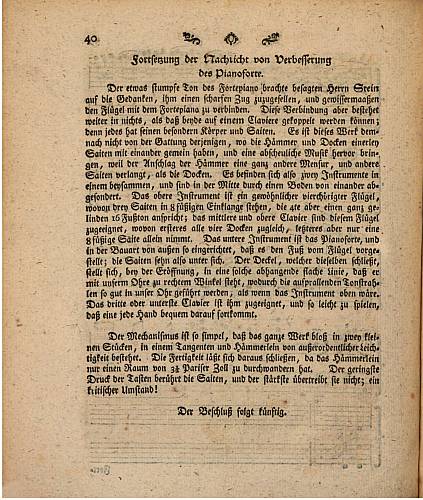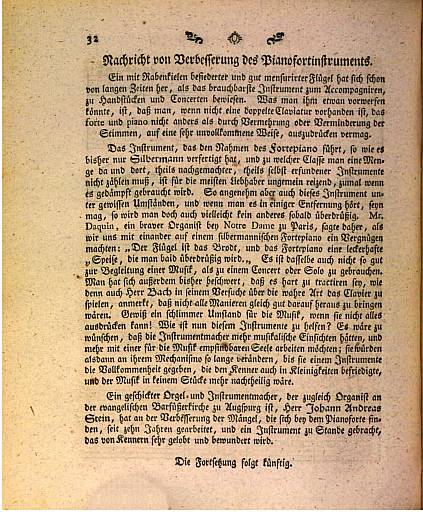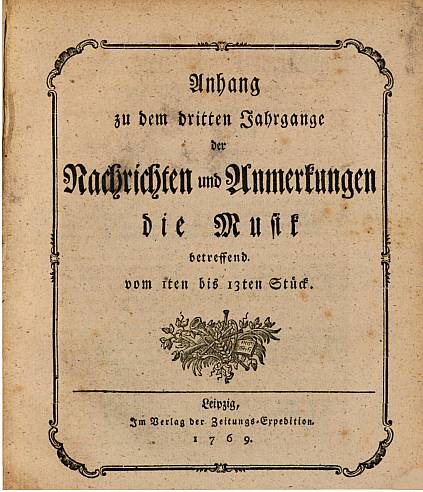Grand by franz jacob Späth/Spath
Southern German / Oberammergau (1761)
At present in the state of documentation resp. plan reestablishment
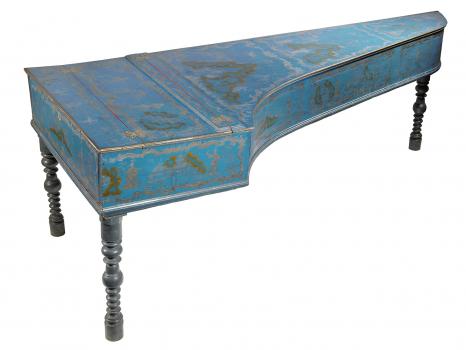
This outwardly rather spectacular instrument from Heimatmuseum Oberammergau in its present state represents the result of a transformation by an unknown maker from harpsichord, maybe a combination instrument, to a grand piano. This remodelling obviously occurred in the last decades of the 18th century, the original state built by Franz Jacob Späth in Regensburg in 1761 has been tampered with massively. At present the range of the instrument is F' to f3 (61 keys); rather typical for its time and possibly original from beginning.
(a Grand by Späth)
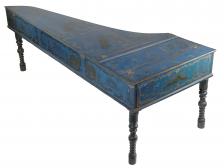
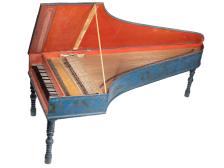
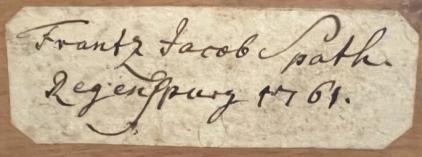



Our documentation faces several tasks and challenges: First documentation and researching the very extensive chinoiserie decoration of the 1760s, secondly the exploration of its assumed original state and the changes during the reshaping into a single-manual piano. Even in its present state it represents a spectacular and important cultural and technical monument deserving detailed research.
The front cheek clearly shows some traces of rough manipulation, Obviously the instrument was shortened at its front, sawn crudely right through painted decoration and wooden profiles. It leads to the assumption that the instrument initially had two manuals and was shortened by the length of the lower manual which was shortened itself and overdone to serve as the new single remaining keyboard.
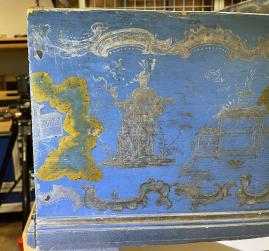
How was the contemporary demand?
![in: Münchner Wochenblat, 15.Christmonat (Decembre) 1784, [p.2]](/wAssets-dt/img/1761-Spath/weblication/wThumbnails/Anzeige_p3_muenchner-wochenblatt-1784-ce37d30e-7eb61692@ll.jpeg)
„Grand for win.“
A key grand, or fortepiano made by Mr Späth in Regensburg, with 2 manuals, one with quills, the second with hammers and four alterations including the framework and box belonging to it, can be won at the 573 rd lottery of 23rd December 1784 by first draw when acquiring a ticket at the price of 1 Gulden 30 available at Mr Emkem collector at the Knödelgasse*
* modern Hartmannstr., Munich City centre
An obviously rather common procedure to get rid of an expensive leftover was making it a lottery win. It indicates that the object in itself found no more buyers but apparently was interesting enough to allure a raffle.
A lottery for a two-manual grand, as explained a combination of harpsichord and piano, should take place before christmas 1784 in Munich.The ad indicated it might have been an interesting and worthy potential christmas present offer.
The indication of a box present reveals the instrument had not been unpacked as sent from the workshop to Munich but hadn't found a buyer.
Even if this Munich lottery had probably nothing to do with this (probably originally similar) instrument from Oberammergau, it gives a sideview on instruments like these by Späth, and when this type of instrument went out of fashion (and the idea arose of modernising).
What kept F.J. Späth occupied in the 1760s:
Producing Instruments and finding a future son in law and successor
from D-DRslub Mscr.Dresd,App.3165/3 (Silbermann archive), pag. 226-228 (correspondence):
Spath (Franz Jacob)
From Regensburg. Wrote 1755 the 10 th of July when he had a 16 foot organ* in the making, in need of a perfect organ maker journeyman, apt in tin works, he asked me for such while he is aware that the best ones from anywhere try to work for me.
* This was in all likeliness the organ for Regensburg Dreieinigkeit (Trinity) church

1764 the 28th of July he wrote again that while being in his 50th year and his strength slowly fading and not having a male successor but 3 daughters he made the decision to make a good christian and able subject, having excelled in organ making, perfectly happy. Since he assumes that I am familiar with organ makers within a fair district around Straßburg he would accept a heavenly benefit if I could recommend an able subject, at best one of my disciples.
On the side he mentioned; Thank God he has a harpsichord of 2000 florins in progress again.
The same year 1764 the 11th of Octobre he repeated his previous intention and his oldest daughter is just 14. he would be pleased if he had a young man who could play keyboard well, is inventive, learning to make, refine and tune a a good pipe. He knows a young organ maker journeyman formerly under contract with him, but no proper player, in urge to become a perfect organ builder. With him the opportunity is insufficient. Therefore he wanted to recommend this just fellow meanwhile working in Saxony asf.
1774 the 12th of December Mr Spath again wrote a polite letter reporting God presented an able son in law by the name of Schmahl organ maker's son from Heilbronn on Neckar. He notes that one had made his honours at [my] blessed brother's in Dresden, welcomed gratiously but could not enter [the workshop] because of my [Späth's] contract. He, however, still has a marriage-minded daughter who he would wish an able artisan of our arts for. This letter he signed Spath & Schmahl. This artist makes a big fuss about his harpsichord-work as can be read p.226 [here above]. A Duke of Waldburg who visited us in 1777 has seen his instruments, and would not praise them.
Fascination combined
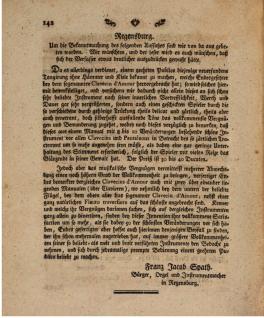
engl. translation here
from: Addenda to third year of news and remarks concerning music. Leipzig 1769.
News of improvement the piano instrument
A raven-quilled and well measured harpsichord has proven for ages to be the most useful instrument for accompaniment for solo and concerts. If something can be complained, might be if not with double manual forte and piano can only be achieved by adding and reducing ranks in a very imperfect way,
The instrument by the name of Pianoforte so as until now only produced by Silbermann and to which here and there a group of imitated or self-invented instruments should be added, is for most amateurs impressingly charming, especially when used damped. So pleasant under special circumstances or heard from a certain distance so annoying like maybe none else after a while. Mr Daquin, a decent organist at Notre Dame in Paris once said when we had our fun with a Silbermann piano: „The harpsichord is daily bread, and the piano a tasty morsel soon losing its appeal." It is also not that apt to accompaniment as to concert or solo. There were also complaints about its hard treatment as remarked by Mr Bach in his treatise about the proper treatment of keyboard that not all intricacies can achieved on it. Certainly a bad circumstance for music if not all delicacies can be expressed. How can this be helped? It would be desirable that instrument makers had more musical insight and would work with musically receptive soul to work on changing the mechanism until giving the instrument the perfection satisfying the experts and no longer spoiling the music.
An able organ and instrument maker, organist as well at Lutheran Discalceds at Augsburg, Mr Johann Andreas Stein, has worked for ten years to improve the flaws found at the piano and produced an instrument very appraised and admired by experts
To be continued:
--------------------------------------------
Continuation
The partly dull tone or the piano gave Mr Stein the idea to add a sharp rank and to combine the harpsichord and piano. This combination consist in a union in one instrument, each its particular body and strings. So this instrument is not of the kind where hammers and quills share the same sets of strings and produce a ghastly music because the hammer attack requires a quite different measure and strings than the quills. So he joined two instruments in one and the soundboard separating in between in centre. Upper side is a common four-choir harpsichord,with three strings in 8' the fourth in 16'. The middle and upper manual are linked to these, the first touching all four strings, the central only one 8'-string the lower instrument is a piano arranged in such way to form the bottom strings facing downward. The lid covering this when opened flaps down in a rectangular way by which the reflected sound waves are directed to the ear just like the instrument would face upwards. The third or lowest manual rules this and so easily for every hand.
The mechanism is so easy consisting only of two pieces, in a tangent and hammer of extraordinary lightness. The ease can be seen in the space traveled by the hammer is 3½ Paris inches. The slightest touch of key touches the strings, the strongest does not overdrive it, a critical feature.
So even Johann Andreas Stein worked at similar concepts in those years.
Who did this conversion when?
"Round up the usual suspects!" But who might have been the "usual suspects"?
"Modernisations" like these appear to have been not uncommon, despite all declarations to the opposite. Its mode clearly different from Späth leads to the assumption that this was not done by Späth & Schmahl but by someone, roughly familiar with piano manufacture and action but outside the prominent workshop traditions.
That the generation of disciples of Silbermann, Späth, Friderici and Stein had no second thoughts about conversions like those, is revealed by an ad of a rather unknown former apprentice or journeyman (and nephew) of Stein, Johann Georg Kuppler, in Bayreuther Zeitungen of 27th of March 1786, who appears rather keen to spread all his experience and his produce following his former masters Stein and Friederici:
To the musical public.
May a revered musical public be informed that the Speyer-born instrument maker, Johann Georg Kuppler, established here who was trained in his art by the famous artisans Mr. Stein in Augsburg and the late Mr. Friderici in Gera, that he can offer the following keyboard instruments made anew cheaply, as, Clavichord's of different sorts, Fortepiano's, grand as well as square, Melodica and Vis a Vis-grands. Quality of sound, precision and longevity of the inner as well as outer structure will testify his recommendation just as he himself might by promptest service; this may be witnessed by the connaisseurs here whose applause he proudly received in his short time. Since so many music lovers in the present decline and deterioration of the quilled harpsichords are provided with or rather burdened by those instruments, these can contact him (if the body of the instruments is still well) to discuss an alteration into piano which he did recently with some good success. Any external beneficiaries or friends willing to handle commisions for him, will be welcome and shall be in the best way rewarded for their efforts. Bayreuth, 18th of May 1786.
Johann Georg Kuppler.


Kuppler, who soon later moved to Nürnberg and his offers may appear - after his history and experience as producer of Stein's inventions Melodica and Vis-à-vis-grand - less astonishing than his direct approach to the music lovers of the 1780s so bothered and „burdened“ by their old harpsichords - und Kuppler's readiness to adapt these by conversion to the new tastes. He certainly was not the only maker of his generation with such ideas and offers to his customers.
Another who offered similar conversions but also hardly responsible for this instrument's considering the distance was Johann Benedikt Ernst Wegmann in Frankfurt on Main, who placed an ad on 13th of October 1786 in the local "Intelligenzblatt der freien Stadt Frankfurt" [p.890]:"... auch macht derselbe aus Flügeln, die noch brauchbar sind, Forte Piano nach der neuesten Art." (... the same produces, from grands [harpsichords] still usable, pianos after newest fashion...) These conversions represent a rather unnoticed transition area between harpsichord and piano culture.
What music was played on it?
In the 1760s new keyboard music flourished. Unfortunately it is unknown today what music was performed at its assumed first destination, Ettal monastery, since the music scores vanished after its dissolution 1803 but at Regensburg where the instrument was built, the editor and publisher of the local newspaper, the "Regensburger Diarium", regularly published ads about the recent music publications available in his shop.
So he recomm]en[ded in an advertissement in No. VII 17th of August 1762, one year later, the newest music for harpsichord by Wagenseil, Josef Antonín Štěpan and [Carl Philipp Emanuel] Bach. by then the most popular composers from Vienna and Berlin. Whether this met the taste of the buyer of this particular instrument is unknown but it certainly represents the majority tastes of the time.

In the vicinity the tastes were characterized by the sonatas of the Landsberg organist Johann Anton Kobrich (1714-1791), published in series from1748 on in the publishing house of Haffner in Nürnberg.
(ex. of Badische Landesbibliothek Karlsruhe)

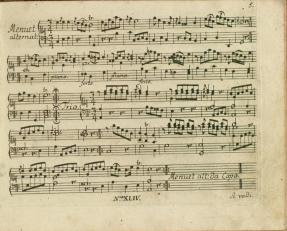
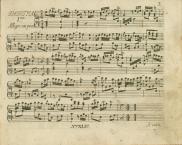


Kobrich's adressees of "lovers" and "beginners" (a few years later Kobrich published a tutor, his "Gründliche Klavierschule") were certainly numerous in this time and region. Dynamic gradation particularly in the final movement, rudimentarily possible on organ or harpsichord but certainly welcome to show the potentials of such a combined instrument shows the actual fashion and modern style but also variability of keyboard instruments of the time.




